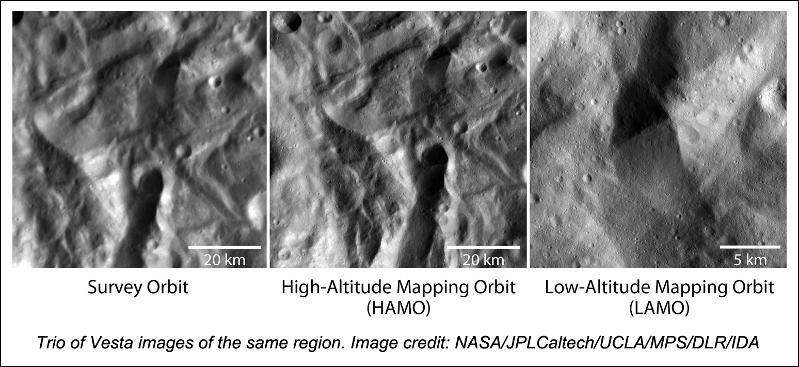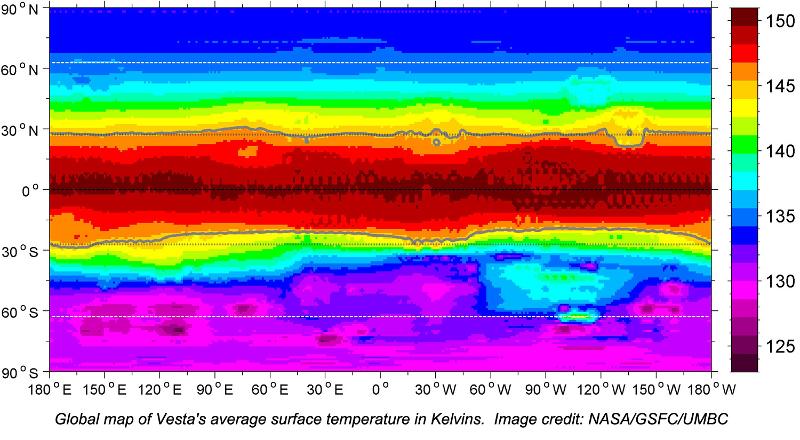 | |
Dawn Mission Outreach E-News 37th Edition February 2012 |
|
|
|
GET THE SKINNY ON DAWN'S MAPPING ORBITS:
SURVEY, HAMO, AND LAMO | |
Dawn has been busily charting Vesta at its Low Altitude Mapping Orbit (LAMO) since December. How does LAMO compare to other mapping orbits? Recall that Dawn caught up to Vesta last summer, moving into orbit around the asteroid as it cruised in its trajectory around the Sun. Since then, the spacecraft spiraled from its 2,700-kilometer (1060 miles) survey orbit to an altitude of about 700 km (42 mi) for the high altitude mapping orbit (HAMO). After weeks collecting data from that perspective, the spacecraft slipped to just 199 km (124 mi) from the surface of the asteroid for LAMO.
Here are Framing Camera images of the same region from each orbit. Notice the improvement in resolution from survey to HAMO, and the detail apparent thanks to LAMO. Find the mountain in each image! Read more!

Each of Dawn's instruments has an ideal data gathering altitude. The Gamma Ray and Neutron Detector (GRaND) and gravity science are the true stars of the show during LAMO. Marc Rayman's recent journal offers a sweet synopsis of these instrument's important work.
How else can you learn more?
✓ Unlock how GRaND calculates elemental abundances through Dawn's GRaND interactive, and team lead, Tom Prettyman's, podcast.
✓ Science team member, Sami Asmar, eloquently describes how gravity science is used to model of the interior of Vesta in his interview.
✓ Keep up with Dawn's Image of the Day.
✓ Read next month's e-News which will highlight science team updates shared at the Lunar and Planetary Science Conference on March 20-23. |
EDUCATION SPOTLIGHT
SPECTACULAR NEW IMAGES ARRIVE FROM DAWN--WHAT DO YOU DO? | |
March 10, 2012
Vision of Discovery Educator Workshops: Art Inspiring Science
Pasadena, CA | Houston, TX | Portland, OR | Laurel, MD
 | Educators describing features their planetary science art.
Image credit: McREL |
Learning to look...looking to learn! Dawn is joining several other NASA Discovery and New Frontiers Program missions for another multi-site educator workshop, A Vision of Discovery. Educators will use the elements of art--shape, line, color, value, texture--to deepen student understanding and analysis of cool images arriving from space.
✓ Scientists will update participants on mission progress.
✓ Designed for both formal and informal, K-12 science educators.
✓ Hands-on and engaging, take fabulous materials back to your classroom!
Sites include Jet Propulsion Laboratory in Pasadena, CA; Johns Hopkins Applied Physics Laboratory in Baltimore, MD; Oregon Museum of Science and Industry in Portland, OR; and Johnson Space Center in Houston TX. For those interested in participating but unable to make it to one of the sites, much of the workshop will be streamed live through NASA's Digital Learning Network.
✓ Visit the Vision of Discovery website for more information and to register.
✓ Join the accompanying webinar.
NASA's Year of the Solar System: Far-ranging Robots
Every month the Year of the Solar System explores a new theme. Explore Far Ranging Robots this month, and take a peek at YSS's March theme: Shadows of the Sun!
|
EXTRA, EXTRA!
VESTA'S POLES COLD ENOUGH TO HARBOR WATER ICE | |
 Though generally thought to be quite dry, roughly half of the giant asteroid Vesta is expected to be so cold, and to receive so little sunlight, that water ice could have survived there for billions of years, according to the first published models of Vesta's average global temperatures and illumination by the Sun. Though generally thought to be quite dry, roughly half of the giant asteroid Vesta is expected to be so cold, and to receive so little sunlight, that water ice could have survived there for billions of years, according to the first published models of Vesta's average global temperatures and illumination by the Sun.
The presence or absence of water ice on Vesta tells scientists something about this world's formation and evolution, e.g. its history of bombardment by comets and other objects, and its interaction with the space environment ("weathering").
✓ Read Dawn's full January 27, 2012 press release from NASA Jet Propulsion Laboratory.
✓ To get a clearer picture of Vesta, check out Dawn's videos and animations. |
|
| |
From Dawn's Chief Engineer, Dr. Marc Rayman:
January 27, 2012
 Dawn is scrutinizing Vesta from its low-altitude mapping orbit (LAMO), circling the rocky world five and a half times a day. The spacecraft is healthy and continuing its intensive campaign to reveal the astonishing nature of this body in the mysterious depths of the main asteroid belt. Dawn is scrutinizing Vesta from its low-altitude mapping orbit (LAMO), circling the rocky world five and a half times a day. The spacecraft is healthy and continuing its intensive campaign to reveal the astonishing nature of this body in the mysterious depths of the main asteroid belt.
The robotic explorer has devoted most of its time to its two primary scientific objectives in this phase of the mission. With its gamma ray and neutron detector (GRaND), it has been patiently measuring Vesta's very faint nuclear emanations. These signals reveal the atomic constituents of the material near the surface. Dawn also broadcasts a radio beacon with which navigators on distant Earth can track its orbital motion with exquisite accuracy. That allows them to measure Vesta's gravity field and thereby infer the interior structure of this complex world. In addition to these top priorities, the spacecraft is using its framing camera and its visible and infrared mapping spectrometer (VIR) to obtain more detailed views than they could in the higher orbits.
✓ Read the complete February Dawn Journal.
✓ For more mission concepts revealed, check out the Dawn Journal archives. |
|
| |
Low Altitude Mapping (LAMO) of Vesta Proceeding Well
January 27, 2012
 Dawn is in good health and using all of its sensors to make detailed measurements of Vesta, following the pattern it has used from the beginning of the low altitude mapping campaign. Dawn is in good health and using all of its sensors to make detailed measurements of Vesta, following the pattern it has used from the beginning of the low altitude mapping campaign.
On January 13, a software bug caused the main computer to reboot and Dawn entered safe mode. The operations team soon detected the spacecraft's condition. They subsequently returned the probe to the correct configuration and resumed normal operations. Engineers understand how to avoid triggering this bug again.
✓ View all of Dawn's journey to--and around--Vesta in mission updates.
✓ Where is Dawn now? |
|
FOLLOW DAWN! |
Get on-the-minute mission and science updates during this exciting year as Dawn zips along in its trajectory to Vesta in the main asteroid belt! Follow the Dawn Mission on Facebook, Twitter, and our RSS Feed. |
|
TELL US WHAT YOU THINK, FORWARD OUR NEWS, SUBSCRIBE! |
The Dawn Education and Public Outreach team is continually seeking ways to improve the mission website and is eager to receive your feedback. Please share your thoughts by completing a brief survey. Please feel free to forward this e-mail to others interested in NASA missions. We welcome new subscribers! Visit the Dawn News and Events page to sign up for the Dawn E-News RSS feed or to join the Dawn mission E-News mailing list. |
|
*************************************************************************************************************************************************************
Dawn Mission Outreach E-News features information about the mission, its outreach website, and products, services, and materials available from the Dawn Education and Public Outreach (E/PO) team. Dawn is the ninth Discovery mission in NASA's Science Mission Directorate and is a collaborative partnership made up of the University of California, Los Angeles; Jet Propulsion Laboratory; Orbital Sciences Corporation; Los Alamos National Laboratory; German Aerospace Center; Max Planck Institute for Solar System Research; Italian Space Agency; and Italian National Institute of Astrophysics. Dawn outreach materials are developed under contract by Mid-continent Research for Education and Learning (McREL), Denver, CO.
|
|
|
|
|
|
|